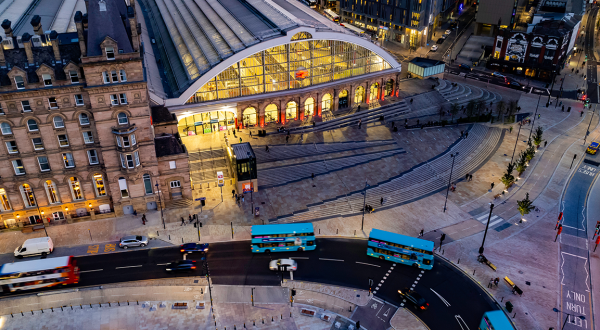One the one hand, travel demand is on the up. And on the other, the level of greenhouse gas emissions needs to come down. So how can these two things be reconciled? Participants at a debate held by Mobility (VINCI Energies) on 8 June 2023 in the Paris offices of Leonard:Paris, the VINCI foresight and innovation platform, agreed on what needs to be done: expand electric vehicles, accelerate a modal shift, develop multi-modal practices and ensure all stakeholders in the transport industry work together.

In 2021 oil accounted for 30.9% of global primary energy consumption, ahead of coal (26.9%) and natural gas (24.4%). This means that fossil fuels alone represent 82.2% of global energy consumption. We know that this energy equation is untenable given the scale and critical nature of environmental and climate issues.
Although all business sectors are concerned, transport infrastructure bears a particular responsibility. “The transport industry is the bad guy when it comes to CO2 emissions,” says Alphonse Coulot, project manager at La Fabrique de la Cité, a think tank set up by VINCI. In France, transport accounts for 43% of CO2 emissions from energy combustion. That is more than global, European and US averages (24%, 31% and 37% respectively).
A historical analysis of trends in transport practices since 1960 shows a phase of regular, sustained and similar increases in three variables – speed, travel demand and emissions. This changed in the 2000s, when the three trajectories levelled out.
The big challenge to be met by 2050, argued Alphonse Coulot, is to decouple travel demand (which is set to keep rising) from the emissions curve (which needs to come down drastically). “Demand will increase while emissions decrease, which means that greater energy sobriety [or restraint], does not necessarily equate to less travel,” he claimed.
More charge points
So we can expect to see more travel in the future, especially road travel, said Louis Du Pasquier, director of the ESCOTA concession contract at VINCI Autoroutes, who explained that transportation was the only sector whose emissions had continued to increase since the 1990s. “Since nine in ten movements of goods, and nine in ten movements of people currently take place on the road network, the big question is: how do we decarbonise roads?”
“We need to increase communication between all players in the ecosystem.”
Louis Du Pasquier advocated a widespread and coordinated deployment of electric vehicles (EVs), in particular relatively small vehicles so as to avoid the need for big batteries. This option would require drivers to stop every two hours in order to charge their batteries for 20 to 30 minutes. “Motorway users already take breaks roughly every two hours, so we can move towards EVs on a massive scale without changing our behaviours. However, the deployment of charge points will need to be stepped up significantly,” he insisted.
But to achieve energy efficient transport infrastructure, models must be changed early on in the value chain, at the construction stage. Christophe Villard, executive director of Société du Grand Paris highlighted the importance of involving the suppliers of the Greater Paris development project in the CO2 emission reduction process.
“The Grand Paris Express transportation project generates 4.4 million tonnes of CO2,” he explained. “Our aim is to reduce that by 25%. This means relying more heavily on fibre-reinforced concrete and ultra-low carbon concrete, which helps us to achieve savings of up to 70% on our emissions. We also produce 48 million tonnes of spoil; so recycling solutions need to be developed.”
Communication is key
A modal shift, which involves a change from road to other forms of transportation, is another major focus of sector decarbonisation. The Walloon example in Belgium could inspire infrastructure industries in France: in 2018 the government of Wallonia launched a programme named FAST (which is French stands for flow, accessibility, health & safety and modal shift) aimed at lowering the share of car use in the transport mix from 83% to 60% by 2030.
“We are developing cycle tracks and waterways to transport goods, and we recently inaugurated a lock that will serve as a transport route for the equivalent of 550 trucks,” explained Denis Cornet, director at the Public Service of Wallonia.
Cédric Kervella, cross-functional project lead at SNCF Réseau, insisted on the need to link all transport modes in order to widen users’ options. However, this multi-modal vision, while broadly accepted on paper, still faces numerous barriers.
“There is a lot of work to be done in terms of culture. We all want to go in the same direction but we’re only at the beginning of the road and we’re still feeling our way. We need to increase communication between all players in the ecosystem if we want to accelerate innovation and change our methods,” he stated. Virginie Willaert, CSR climate director at Egis Transport et Territoires, agrees. She highlighted the collective and cooperative dimension of the energy transition and stressed the importance of collaboration “between everyone involved in the design, construction and operation of transport infrastructure.”
Involving the markets
This drive towards energy efficient infrastructure calls for clearer recognition of the key role that the systems play in the acceleration, scale-up and long-term impact of the energy transition. Unlike civil engineering structures, which use a lot of energy and produce excessive emissions during the construction phase, these systems consume little, with consumption continuing in a controlled manner for several decades.
“It’s important that markets promote models in which businesses agree to commit to system consumption levels through evaluation indicators. Applied during the first months of the transport infrastructure’s life, the indicators could result in penalties in the event of non-compliance with the stated commitments,” noted Virginie Willaert. She went on to say that she regretted the fact that markets do not adequately encourage or reward design processes based on a sparing use of energy.
Funding modal shifts
Policies, infrastructure and services still need to be funded though. Alphonse Coulot made reference to experiments being conducted in some large cities. In Oslo (Norway), EVs are ten years ahead of most other national markets, and there are plans to levy further taxes to fund public transport. Hong Kong intends to harness its land, which is scarce and expensive within a limited surface area. In Singapore, people have to pay €35,000 per year to drive, and the toll charge for entering the city is linked to how much traffic there is. And finally Copenhagen (Denmark) is considering funding bikes (used daily by 62% of residents) by taxing cars and possibly, to a lesser extent, bikes themselves.
14/09/2023





